Top 8 Ritual Items of Tibetan Buddhism
- by Zoe
- Last Updated: 2024-05-24
Tibetan Buddhist items refer to the objects used by monks in Buddhist activities and rituals. Those Buddhist sacred objects are endowed with special meaning by the Dharma so that they are no longer ordinary artifacts, but more sacred and solemn. There are many types of Tibetan Buddhist ritual items with different purposes, styles, and sizes, such as the prayer wheel, prayer beads, conch shell, vajra, and so on. Most of them drew on the appearance of Indian Buddhist items and integrated their own features. Tibetan Buddhist items are commonly used for offerings to the Buddhas, adorning the Bodhimanda and practicing dharma. This article mainly introduces the eight particular Tibetan ritual items.
Prayer Bells
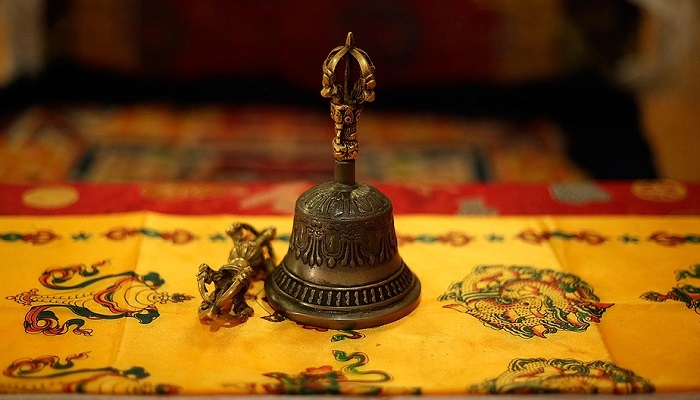
Prayer bell is one of the necessary Buddhist ritual items including agogo, vajra bells, etc. for lamas and monks when they are chanting and practicing. The material of the Buddhist prayer bell is mostly copper, the shape is the bell mouth, and the handle is in the shape of half vajra, with a bell tongue inside and various designs engraved on the surface. In Tibetan Tantric Buddhism, the Tibetan Prayer Bell has profound connotations. The bell symbolizes Prajna (the highest and purest form of wisdom) and is usually used together with the vajra. The vajra that bears it represents the five troubles or disturbing feelings of the heart that have become the five supreme wisdom through the Vajrayana. The upper part of the bell is equivalent to the body of the Buddha, the lower part is equivalent to the language of the Buddha, and the vajra is in its heart. The meaning of the Tibetan Prayer Bell is to mind the empty nature of all things and promote a sense of peace and calmness. The bell is also a musical instrument, together with other sacred instruments such as the Tibetan-drum (damaru), are played in rituals as musical offerings to the Buddhas and other gods.
Vajra
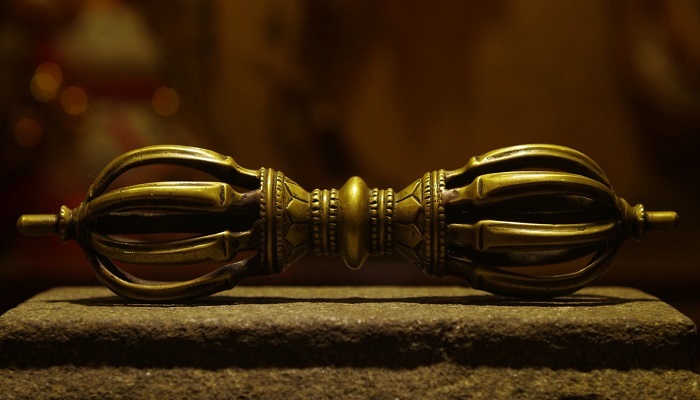
Vajra(Tibetan: Dorje) was originally an ancient Indian thunderbolt weapon carried by the Vedic god Indra but later adopted by Tantric Buddhism as a ritual weapon. Vajra is related to the word for diamond, symbolizing firmness of spirit and spiritual power. Vajras are mostly made of gold, silver, copper, iron, and fragrant wood, and generally have three strands of pestles, five strands of pestles, and nine strands of pestles in shape. In Tantric Buddhism, the vajra is usually used with the bell in many rites by lamas. The vajra (symbolizing the male principle, fitness of action) is held in the right hand and the bell (symbolizing the female principle, intelligence) in the left hand, the interaction of the two ultimately leading to enlightenment.
Tibetan Drum
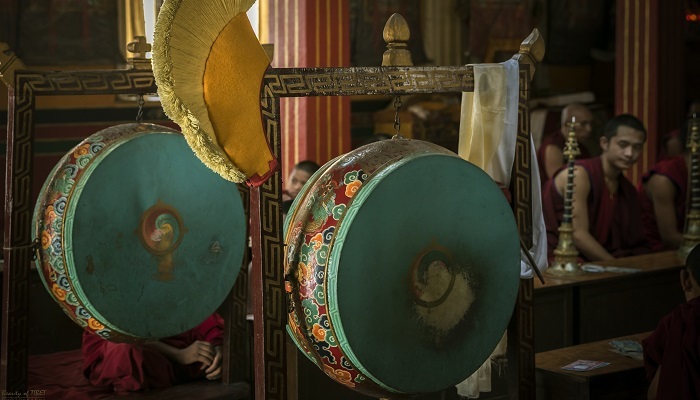
Tibetan Drum(Tibetan: Damaru) is a two-headed drum. Tibetan monks typically use this drum as a sacred implement and perform the item in Tibetan Buddhist rituals like celebrations of Buddhist festivals and sort of Buddhist ceremonies, such as Living Buddha’s enthronement and opening-of-light ceremony.
There are different kinds of damaru like the curved-hammer damaru, the skull damaru, the bronze damaru, etc.
The distinctive feature of the curved-hammer drum is its hammer, which bends like a bow. The drum head is about 1 meter in diameter and has a handle under it. In Buddhist chanting, the Lamas recite the Buddhist sutras while holding the drum handle in the left hand and beating the drum head with the hammer in the right hand, just like an accompaniment.
The skull damaru (Tibetan: thöpa) is usually made of wood, ivory, and human skull bone with leather heads at both sides. The waist has gemstones and gold flakes inlaid in the hoop and a ribbon tail called a chöpen attached to it. In Dharma Assembly, the skull drum is often played with Buddhist Vajra Bells.
Tibetan Buddhist Conch Shell
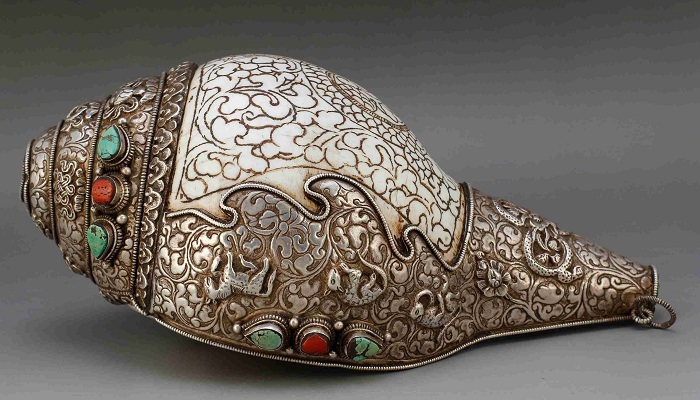
The Conch (Tibetan: Shankha) is one of the eight auspicious symbols of Buddhism as well as an instrument.
Tibetan monks apply these items in Buddhist rituals. They use these objects to awaken disciples from the deep slumber of ignorance and urge them to accomplish the welfare of others. It is a way of spreading Buddha’s teachings and bringing peace to living beings, which has a history of more than two thousand years.
According to legend, when the Buddha Shakyamuni "turned the wheel of dharma" (teaching dharma) in the Sarnath for the first time, his voice was as loud as the sound of a large conch, resounding everywhere. Śakra (the ruler of Heaven) presented the Buddha with a right-turning white conch shell representing the deep and pervasive sound of the dharma. Since then, the right-turning white conch shell has become a symbol of good luck.
Mala Beads
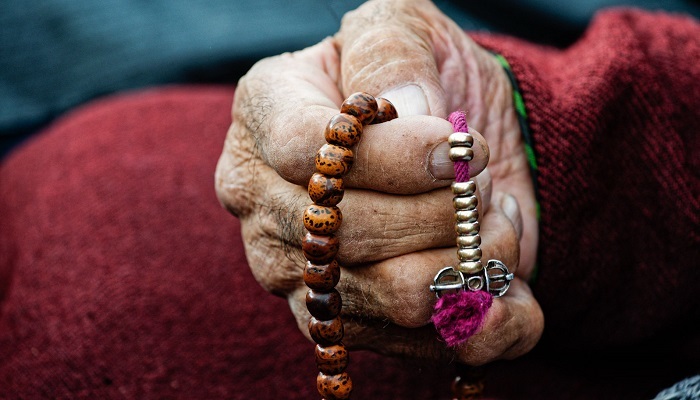
A mala or japamala is a string of prayer beads, one of the Tibetan Buddhist ritual items. When practicing the "mandala offering", one of the “preliminary practices” for accumulating merit, the prayer beads help Buddhist monks to focus on the meaning of the mantra rather than counting rounds while chanting.
Tibetan Buddhist mala beads usually consist of 108 beads that are kept together with a string, though 25 beads sometimes for easier counting. There's one Guru bead that is larger than the rest. It acts as the starting and ending marker for the mantra.
There are many kinds of materials. In Tibetan Buddhism, the prayer beads made from the Bodhi tree seeds are more commonly used. According to the Buddhist scriptures, the Buddha once attained enlightenment under the Bodhi tree, so the seeds of the Bodhi tree have the symbolic meaning of achieving the ultimate happiness. Believers will gain more merits while using the Bodhi prayer beads during both Tantric practice and Exotoric practice.
Ghau Box
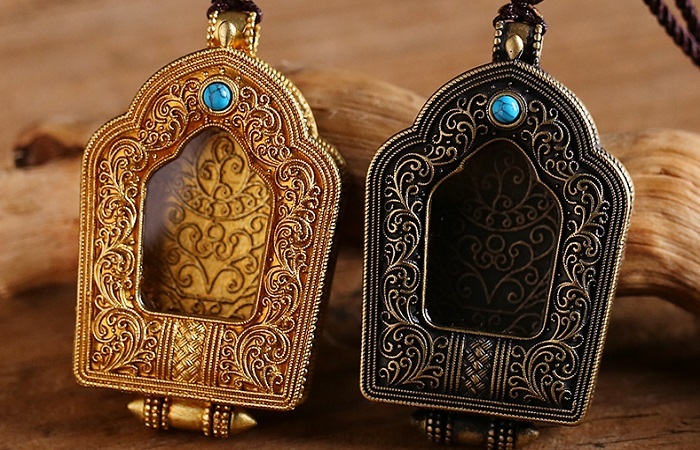
A Ghau is a Tibetan Buddhist amulet or small-size prayer box that can be worn. These Buddhist objects are generally made of gold, silver, or copper. The outside is usually engraved with exquisite patterns, and some are even inlaid with turquoise, pearls, coral, or other gemstones. The inside holds a Buddha statue or Buddhist scripture made from metal or clay. The prayer box helps to resist evil spirits and keep the family members safe and healthy, as well as produce blessed rewards.
Tibetan Prayer Wheel
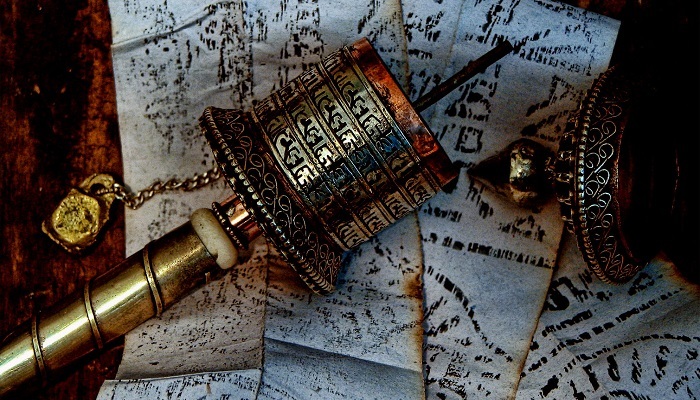
A prayer wheel is one of the Tibetan ritual items used for praying. Spinning a prayer wheel is the best way for Tibetan Buddhists to accumulate merits and purify the bad karmas. It is very common in Tibet.
There are mainly two types. One is the hand prayer wheel (Mani wheel), which is made of gold, silver, or copper, embossed with beautiful patterns, very often the eight auspicious symbols, and engraved with Six Character Great Bright Mantra. It contains scriptures. And equipped with a rotatable shaft. One turn of the mani wheel is equivalent to chanting once. The other is the Row installations set side by side in a row in Tibetan monasteries, which are made of wood and metal. On the outside of the wheel body most commonly write the mantra "Om Mani Padme Hum", and the inside contains Buddhist scriptures. According to the Tibetan Buddhist tradition, every turning of the cylindrical tube brings the same meritorious effect as reciting the mantras orally once.
Tibetan Butter Lamp
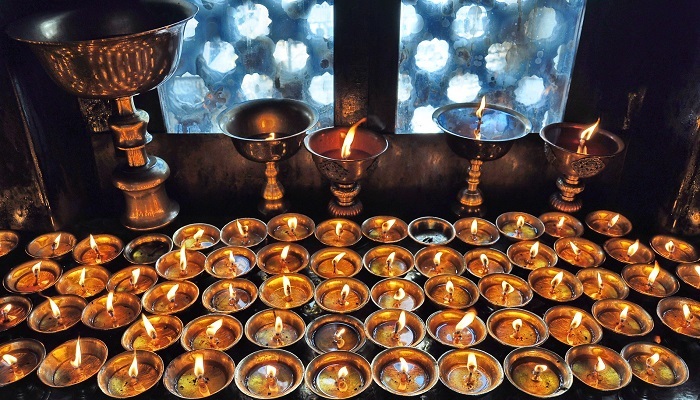
A butter lamp is an oil lamp traditionally burnt with clarified yak butter. It is one of the ritual items in Tibetan Buddhism supplied for the offering.
A conspicuous feature of Tibetan monasteries is the ever-burning butter lamps. Tibetan Buddhists considered butter lamps as the light of the spirit, holding it a very important status in their minds. They are believed to banish darkness and convert the substance of the world into illumination. The burning lamps can eliminate visual obstacles and ignorance so that Buddhists gain a wise mind and will never get lost in the darkness of the world.
In addition to the Tibetan temples, you can also see ever-burning butter lamps in the homes of ordinary Tibetans. On occasions when Tibetans invite monks to chant for the family or pray for deceased relatives, they would light up a few or hundreds of butter lamps at home. Worshipping butter lamps in front of Buddha can pray for the health and longevity of the elderly, auspiciousness and peace of the children, and the happiness of the whole family in return.
Related Articles
- Permit Without Tour
- Tibetan Butter Sculpture
- Things You May Know about Tibetan Buddhism
- Tibetan Thangka Painting
- Prayer Wheel - Every Turn is Equivalent to Chanting Once
- Inside Tibet Train
- Tibetan Sound Bowls
- Major Buddhist Holidays & Festivals of Tibetan Buddhism
- Tibet Vacation Cost
- Temple of Heaven
Email response within 0.5~24 hours.



Typically Asked Questions from Our Clients
Asked by Kris***
Dear Sir
I want to buy Ghau Box with Green Tara Pendent in it. I want it in copper. Please help me , I have serious financial problems, because of this owing many people are cursing me. My health is not good too. Due to business problem many enemies are created. Pls save me, I used to chant Green tara mantra and am still surviving. If I can speak to any of the Tibet Monk I will be very happy. Please help..suffering so much with tears daily.
Dear Krishnaveni, Please let me know where you are so that we can ask the post office if we can deliver that Ghau Box to you as there're some restrictions for religious stuff. And for talking to a monk, unless you come to Tibet on your own, we can't help on this matter cos it's prohibited.